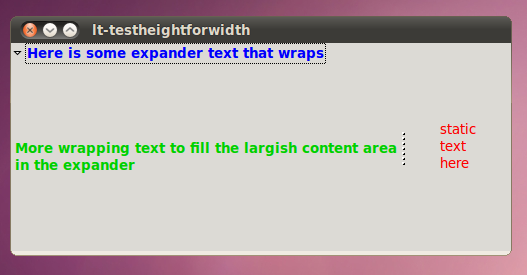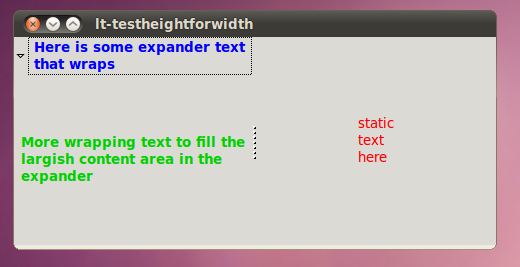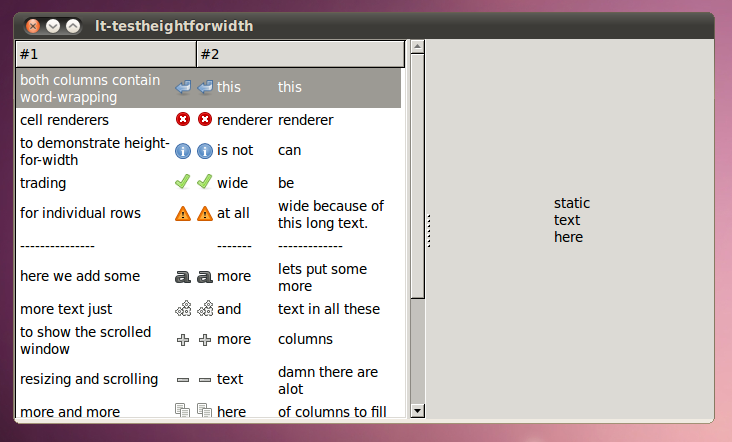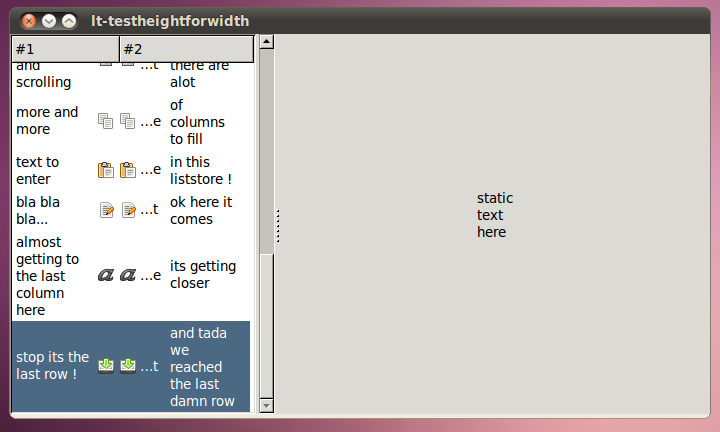These last weeks I’ve been working on finishing the remaining bits of the height-for-width layout system for GTK+.
The GtkExtendedLayout interface, which has recently been renamed to GtkSizeRequest has been merged into GTK+ recently with only some basic features leveraging the new code (the new GtkSizeRequest interface allows widgets to trade height for width when negotiating their geometry, read this informative post for more details on how this works).
I’m going to be putting a branch together to be reviewed but here’s a sneak preview of what’s been added in height-for-width land.
Wrapping expander labels:

When the expander is allocated something smaller:

At it’s smallest size:

Ok ok I know expanders are not that exciting… I’m only posting them cause the screenshots have pretty colours in them…
Naturally sizing Tree Views
Ok this is the juice, as you might guess working anything new into the treeview code is … some kind of nightmare… so first the easy part… here are some ellipsizing cell renderers packed into some columns in a view to show how it naturally sizes:

And when you shrink it:

Wrapping Cell Renderers in Tree Views
Ok heres the wild stuff, first of all I have to say I’m not very proud of all the cute kittens I had to slay to get this done… that is to say that there is an interesting new problem for scrolled windows that parent height for width widgets that may result in deadly feedback loops that lockup your desktop… thankfully I found a trick to avoid it. It’s not that pretty and in the long term the hack should be replaced… with… well with something generally more kind to your kittens.
All that said… it does work and calculate row-height for width asynchronously in the background and only when columns are set to resize etc etc… hopefully this wont be much of a performance hit for views that handle large datasets.

The above shows the treeview at its full width; it’s packed in a scrolled window with automatic scrollbars.
When you shrink the view the row heights will be recalculated and redisplayed, the horizontal scrollbar of the scrolled window will only appear if the child view is allocated less than its minimum possible width.

This particular view can be resized very slim, just because the minimum width-chars of the renderers are not set and so they are all permitted to get pretty small:

While I’m happy to have got as far as wrapping text in treeview’s; that was only the hardest challenge of the GtkCellRenderer brand – after this there is still more to be done for GtkIconView, GtkCellView and consequently, GtkComboBox.
And of course, all of this fancy cell renderer stuff is going to have to pass review and all… but we’re getting there !
And I’m proud to say that all these recent developments have been brought to you by Openismus GmbH.
Enjoy !